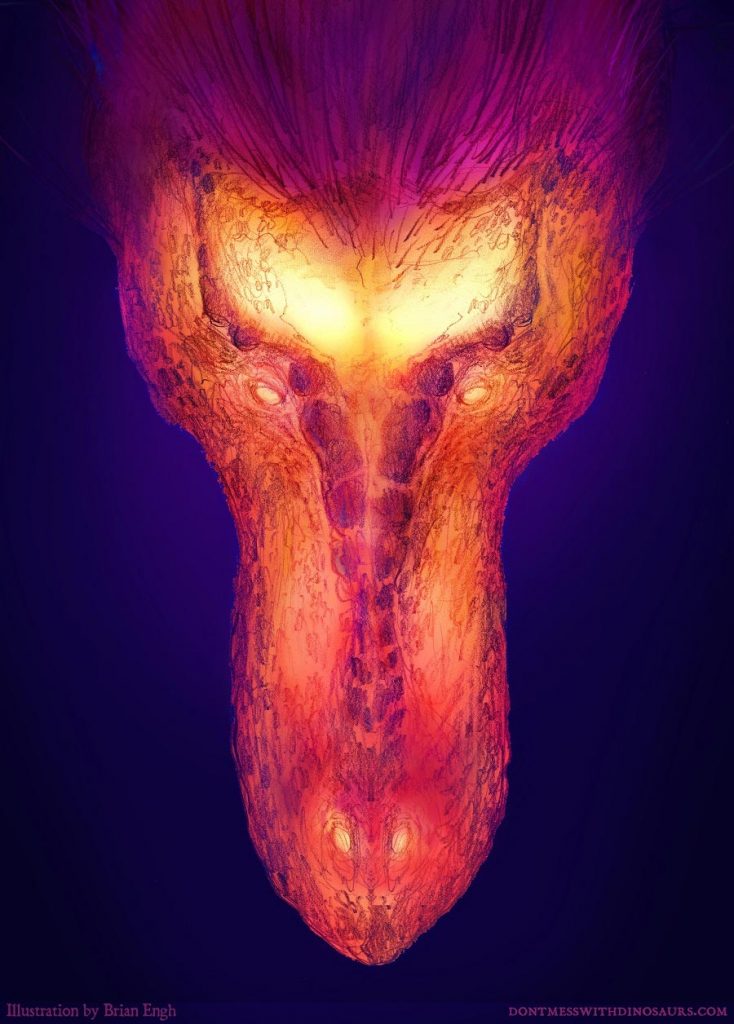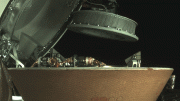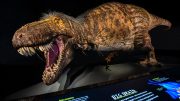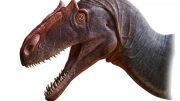
A graphic thermal image of a T. rex with its dorsotemporal fenestra glowing on the skull. Illustration courtesy of Brian Engh.
Tyrannosaurus rex, one of the largest meat-eating dinosaurs on the planet, had an air conditioner in its head, suggest scientists from the University of Missouri, Ohio University and University of Florida, while challenging over a century of previous beliefs.
In the past, scientists believed two large holes in the roof of a T. rex’s skull — called the dorsotemporal fenestra — were filled with muscles that assist with jaw movements.
But that assertion puzzled Casey Holliday, a professor of anatomy in the MU School of Medicine and lead researcher on the study.
“It’s really weird for a muscle to come up from the jaw, make a 90-degree turn, and go along the roof of the skull,” Holliday said. “Yet, we now have a lot of compelling evidence for blood vessels in this area, based on our work with alligators and other reptiles.”
What do the t-rex, crocodiles and alligators have in common? Casey Holliday, a professor of anatomy at MU, used thermal imaging to find that these three creatures used an internal cooling system to stay cool in the heat.
Using thermal imaging — devices that translate heat into visible light — researchers examined alligators at the St. Augustine Alligator Farm Zoological Park in Florida. They believe their evidence offers a new theory and insight into the anatomy of a T. rex’s head.
“An alligator’s body heat depends on its environment,” said Kent Vliet, coordinator of laboratories at the University of Florida’s Department of Biology. “Therefore, we noticed when it was cooler and the alligators are trying to warm up, our thermal imaging showed big hot spots in these holes in the roof of their skull, indicating a rise in temperature. Yet, later in the day when it’s warmer, the holes appear dark, like they were turned off to keep cool. This is consistent with prior evidence that alligators have a cross-current circulatory system — or an internal thermostat, so to speak.”
Holliday and his team took their thermal imaging data and examined fossilized remains of dinosaurs and crocodiles to see how this hole in the skull changed over time.

A graphic thermal image of a T. rex skull. MU study suggests blood vessels acted as an internal thermostat on a T. rex, much like alligators have today for body temperature control. Illustration courtesy of Brian Engh.
“We know that, similarly to the T. rex, alligators have holes on the roof of their skulls, and they are filled with blood vessels,” said Larry Witmer, professor of anatomy at Ohio University’s Heritage College of Osteopathic Medicine. “Yet, for over 100 years we’ve been putting muscles into a similar space with dinosaurs. By using some anatomy and physiology of current animals, we can show that we can overturn those early hypotheses about the anatomy of this part of the T. rex’s skull.”
Reference: “The Frontoparietal Fossa and Dorsotemporal Fenestra of Archosaurs and Their Significance for Interpretations of Vascular and Muscular Anatomy in Dinosaurs” by Casey M. Holliday, William Ruger Porter, Kent A. Vliet, and Lawrence M. Witmer, 1 July 2019, The Anatomical Record.
DOI: 10.1002/ar.24218
The study, “The Frontoparietal Fossa and Dorsotemporal Fenestra of Archosaurs and Their Significance for Interpretations of Vascular and Muscular Anatomy in Dinosaurs,” was published in The Anatomical Record. Other authors on the study include Ruger Porter at Ohio University. Funding was provided by grants from The Jurassic Foundation, Society of Vertebrate Paleontology Richard Estes Memorial Grant, Ohio University Student Enhancement Award, Ohio University Graduate Student Senate, Ohio University Departments of Biological and Biomedical Sciences, SEC Visiting Faculty Travel Grant, Richard Wallace Faculty Incentive Grant, National Science Foundation (IBN‐0407735, IOS 1457319, EAR 163753, IBN‐9601174, IOB‐0343744, IOB‐0517257, IOS‐1050154, IOS‐1456503) and the University of Missouri Department of Pathology and Anatomical Sciences. The content is solely the responsibility of the authors and does not necessarily represent the official views of the funding agencies.









Be the first to comment on "Scientists May Have Finally Solved the Mystery of Bizarre Holes in T. Rex Heads"